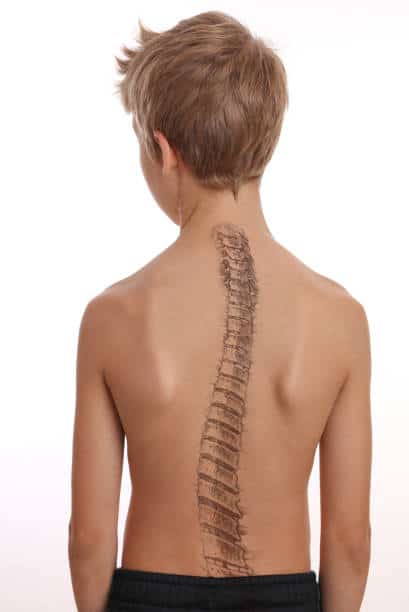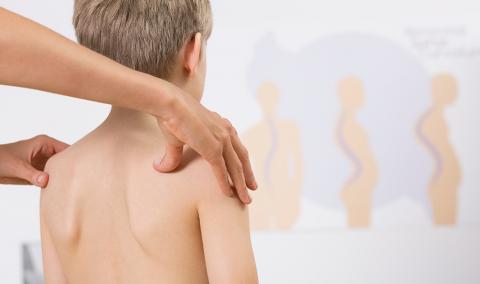What is Scoliosis?
Scoliosis is a medical condition that causes an abnormal curvature of the spine, which can affect a person’s posture and overall body alignment. The curvature can occur in different parts of the spine and can vary in severity.
Treatments that work well with Scoliosis:
In some cases, scoliosis can be mild and not cause any noticeable symptoms, while in other cases, it can cause pain, discomfort, and mobility issues. It can also lead to breathing problems, heart problems, and other complications in severe cases.
Scoliosis can develop at any age, but it’s most commonly diagnosed during adolescence when the growth spurts occur. There are several different types of scoliosis, and the treatment options vary depending on the severity of the curvature, the age of the patient, and other factors. Treatment may include observation, bracing, manual therapy, or even surgery.
Is there a known cause?
The exact cause of this type of spine curvature is not always known, but some cases are linked to genetics or birth defects that affect the development of the spine. Other factors that may contribute to scoliosis include poor posture, muscle imbalances, and certain medical conditions such as cerebral palsy and muscular dystrophy.
Scoliosis compared to other spine curvatures like lordosis or kyphosis gets more complicated. Unlike lordotic and kyphotic curvature, scoliosis is three-dimensional. The changes in vertebrae are in the coronal, sagittal, and axial planes. A coronal plane is a vertical plane from head to foot and parallel to the shoulders, dividing the body into anterior (front) and posterior (back) sections. The sagittal plane divides the body into right and left halves. The axial plane is parallel to the plane of the ground and at right angles to the coronal and sagittal planes.
To make it easier to understand, scoliosis affects the vertebrae that side bend on one side and rotates to the opposite side. It can have C shape, but also S shape and in more severe cases double S shape. It can happen in the cervical, thoracic, or lumbar spine.
Few important facts about scoliosis
- Each of us has slight scoliosis ( lateral flexion of the spine )
- Scoliosis is a side curvature of the spine 10 degree and higher.
- Idiopathic scoliosis ( IS ) can occur at any time during childhood and adolescence
- It mostly appears in 3 period of grown spurs : 6 – 24 months, 5 -8 years and 11 – 14 years of life.
- After approximately 2/3 of the period of pubescent growth spurt, girls experience menarche, which indicates that the peak of growth has been passed, with a gradual decrease in the risk of scoliosis progression.
- In adulthood, IS may intensify as a result of progressive osseous deformities and collapsing of the spine
- 20% of scoliosis is secondary to another pathological process
- 80% are cases of idiopathic scoliosis
- Countries with less sun in a year have higher number of people with scoliosis
The diagnosis of scoliosis usually involves a physical examination and imaging tests such as X-rays, CT scans, or MRI scans. The severity of scoliosis is typically measured in degrees, with a mild curvature being less than 20 degrees and a severe curvature being greater than 40 degrees.
If scoliosis is diagnosed early, it may be possible to prevent the progression of the curvature through non-surgical methods such as manual therapy, osteopathy, physical therapy and bracing. However, in some cases, surgery may be necessary to correct the curvature and prevent further complications.
Overall, scoliosis can have a significant impact on a person’s physical health, quality of life, and self-esteem.
In addition to the physical effects, scoliosis can also have psychological effects on individuals, particularly children, and adolescents. The condition can cause a visible deformity that can lead to self-consciousness, embarrassment, and bullying. It’s important to provide emotional support and counseling to individuals with scoliosis to help them cope with the condition.
Prevention of scoliosis is not always possible, but there are some steps individuals can take to reduce their risk. These include maintaining good posture, exercising regularly to promote muscle strength and flexibility, and avoiding carrying heavy backpacks or bags that can strain the spine.


Osteopathic approach to treat Scoliosis
Osteopaths may use a variety of techniques to treat scoliosis, depending on the severity of the condition and the individual patient’s needs. Some of the techniques commonly used by osteopaths to treat scoliosis include:
Manual therapy: Osteopaths may use hands-on techniques such as massage, stretching, and joint mobilization to improve spinal alignment and mobility.
Exercise therapy: Specific exercises can help improve strength and flexibility in the muscles surrounding the spine, which can help reduce the progression of the scoliosis.
Postural advice: Osteopaths may provide advice on how to maintain good posture throughout the day to reduce stress on the spine and prevent further curvature.
Bracing: In some cases, osteopaths may recommend bracing to help support the spine and prevent the further progression of scoliosis.
It’s important to note that osteopathic treatment for scoliosis is not a cure, but rather a way to manage symptoms and improve quality of life. Treatment may be ongoing, and individuals with scoliosis should continue to see their healthcare provider regularly to monitor their condition and adjust their treatment plan as necessary.
Osteopathic practitioners take a holistic approach to treating scoliosis, which means they consider the whole person, not just the specific area affected by the condition. This approach recognizes that the body is a complex system of interconnected parts that work together to maintain health and well-being.
Treatment for scoliosis may also involve addressing any underlying issues that could be contributing to the condition, such as muscle imbalances, postural habits, or other medical conditions. They may use diagnostic techniques such as palpation, range of motion testing, and postural analysis to identify these underlying issues and develop a personalized treatment plan.
In addition to hands-on techniques, Osteopathic practitioners may also recommend lifestyle modifications such as changes to diet and exercise, stress reduction techniques, and other self-care strategies to support overall health and wellness.
What other treatments can be beneficial for treating scoliosis?
Massage therapy can be helpful in managing the symptoms of scoliosis, but it is not typically used as a primary treatment for the condition. Massage therapists may use techniques such as deep tissue massage, myofascial release, and trigger point therapy to help reduce muscle tension, improve circulation, and promote relaxation.

Massage therapy can be particularly beneficial for individuals with scoliosis who experience muscle pain and tension due to the abnormal curvature of the spine. By reducing muscle tension and improving circulation, massage therapy can help alleviate pain, improve mobility, and promote overall well-being.
Another treatment option can be Acupuncture. While acupuncture is not typically used as a primary treatment for scoliosis, it may be a helpful complementary therapy for managing symptoms and promoting overall well-being.
Acupuncture can help reduce muscle tension, improve circulation, and stimulate the body’s natural healing processes. By promoting relaxation and reducing stress, acupuncture can also help alleviate pain and discomfort associated with scoliosis.
Individuals with scoliosis should work with their healthcare provider to develop a comprehensive treatment plan that may include a combination of medical treatments, physical therapy, bracing, and other complementary therapies such as acupuncture. A multidisciplinary approach to scoliosis treatment can help individuals manage their symptoms, improve spinal alignment, and maintain overall health and well-being.